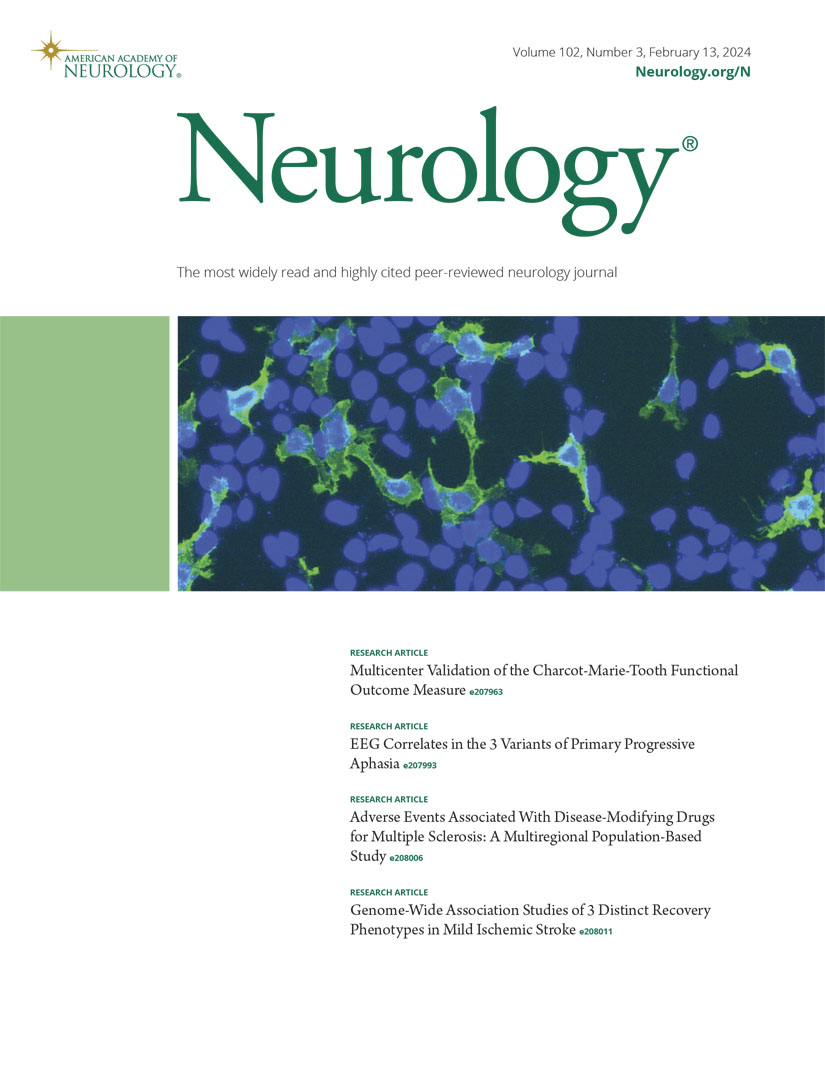2级和3级胶质瘤患者停用抗癫痫药物的长期随访结果:一项前瞻性观察研究
IF 7.7
1区 医学
Q1 CLINICAL NEUROLOGY
引用次数: 0
摘要
背景和目的本研究的目的是评估2级和3级弥漫性胶质瘤患者停药与继续服用抗癫痫药物后癫痫复发的长期结果。方法进行前瞻性多中心观察性研究,于2014年1月至2016年5月从荷兰3家神经肿瘤门诊诊所招募患者。主要纳入标准为:发作史≥1次,并开始ASM;疾病临床和放射学稳定≥12个月;自最后一次抗肿瘤治疗之日起≥12个月无癫痫发作,或如果在最后一次抗肿瘤治疗后发生癫痫发作,自最后一次癫痫发作之日起≥24个月无癫痫发作。主要观察指标为复发发作时间。使用竞争风险模型来估计ASM组(即ASM停止vs ASM继续)以死亡为竞争事件的复发性癫痫发作的累积发生率。ASM组不符合比例风险假设;因此,构建了2个不同时间间隔(1年)的Cox模型。置信区间不能排除临床上重要的癫痫发作风险增加。本文章由计算机程序翻译,如有差异,请以英文原文为准。
Long-Term Follow-Up Results of Antiseizure Medication Withdrawal in Grade 2 and 3 Glioma Patients: A Prospective Observational Study.
BACKGROUND AND OBJECTIVES
The aim of this study was to evaluate the long-term results of seizure recurrence after antiseizure medication (ASM) withdrawal vs continuation in patients with diffuse glioma, grades 2 and 3.
METHODS
A prospective multicenter observational study was conducted, and patients were recruited from January 2014 until May 2016 from 3 neuro-oncology outpatient clinics in the Netherlands. The main inclusion criteria were as follows: history of ≥1 seizure, for which ASM was started; clinically and radiologically stable disease for ≥12 months; and seizure freedom for ≥12 months from the date of last antitumor treatment or seizure freedom for ≥24 months from the last seizure if seizures occurred after the last antitumor treatment. The primary outcome was time to recurrent seizure. A competing risk model was used to estimate cumulative incidences of recurrent seizure for ASM groups (i.e., ASM withdrawal vs ASM continuation) with death as the competing event. The proportional hazard assumption was violated for the ASM group; therefore, 2 Cox models were constructed for different time intervals (<48 months and ≥48 months since study inclusion).
RESULTS
A total of 71 patients were included (39 men [55%] and 58 older than 40 years [82%]); 46 patients with glioma (65%) were in the ASM withdrawal group and 25 (35%) in the ASM continuation group. The cumulative incidence of a recurrent seizure at 48 and 96 months was 48% (95% CI 33%-61%) and 66% (95% CI 48%-78%) for the ASM withdrawal group vs 28% (95% CI 12%-46%) and 52% (95% CI 31%-70%) for the ASM continuation group. The risk of a recurrent seizure differed in the 2 time intervals between the ASM continuation group (reference) and the ASM withdrawal group (cause-specific adjusted hazard ratio [aHR] 2.32 [95% CI 0.93-5.81], p = 0.071, during <48 months, and cause-specific aHR 0.73 [95% CI 0.21-2.49], p = 0.611, during ≥48 months since study inclusion).
DISCUSSION
Risk of recurrent seizure when withdrawing ASM was not statistically significantly higher in patients continuing ASM. However, a clinically relevant higher percentage of patients had a recurrent seizure in the ASM withdrawal group compared with the ASM continuation group. The lack of a statistical difference may be explained by the small sample size. Larger studies are needed to confirm these findings. Our results suggest that ASM withdrawal should be initiated cautiously and only when necessary.
CLASSIFICATION OF EVIDENCE
This study provides Class III evidence that withdrawal of ASM does not significantly increase the risk of recurrent seizures in patients with glioma with stable disease and no seizures for >1 year. Confidence intervals do not exclude a clinically important increased risk of seizures.
求助全文
通过发布文献求助,成功后即可免费获取论文全文。
去求助
来源期刊

Neurology
医学-临床神经学
CiteScore
12.20
自引率
4.00%
发文量
1973
审稿时长
2-3 weeks
期刊介绍:
Neurology, the official journal of the American Academy of Neurology, aspires to be the premier peer-reviewed journal for clinical neurology research. Its mission is to publish exceptional peer-reviewed original research articles, editorials, and reviews to improve patient care, education, clinical research, and professionalism in neurology.
As the leading clinical neurology journal worldwide, Neurology targets physicians specializing in nervous system diseases and conditions. It aims to advance the field by presenting new basic and clinical research that influences neurological practice. The journal is a leading source of cutting-edge, peer-reviewed information for the neurology community worldwide. Editorial content includes Research, Clinical/Scientific Notes, Views, Historical Neurology, NeuroImages, Humanities, Letters, and position papers from the American Academy of Neurology. The online version is considered the definitive version, encompassing all available content.
Neurology is indexed in prestigious databases such as MEDLINE/PubMed, Embase, Scopus, Biological Abstracts®, PsycINFO®, Current Contents®, Web of Science®, CrossRef, and Google Scholar.
 求助内容:
求助内容: 应助结果提醒方式:
应助结果提醒方式:


